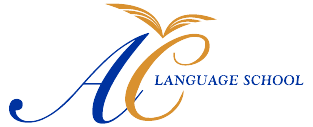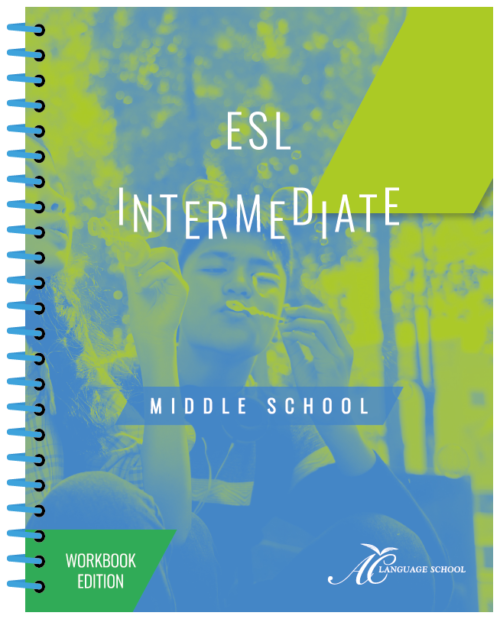- Define economic forecasting and its value in foreign policy planning.
- Interpret key economic indicators relevant to global affairs.
- Assess short- and long-term trends in macroeconomic data.
- Analyze country and regional economic risks.
- Use scenario analysis for planning under uncertainty.
- Communicate forecasts in policy briefs and diplomatic messaging.
- Evaluate the reliability and limitations of economic projections.
- Integrate forecasts into multilateral or bilateral strategic planning.
- Design economic dashboards for diplomatic missions.
- Create a forecasting-informed policy strategy for a global issue.
-
 Course Description: This course introduces economic forecasting tools and their strategic application in foreign policy planning. Participants will learn to interpret macroeconomic trends, assess regional risks, and integrate economic projections into diplomatic strategy. The course emphasizes scenario analysis, modeling basics, and real-world data to support resilient, forward-looking policy decisions. Course Length: 6 weeks (36 total instructional hours) Proficiency Level: Advanced Prerequisite: Completion of a lower-intermediate ESL course or equivalent language proficiency Course Objectives:
Course Description: This course introduces economic forecasting tools and their strategic application in foreign policy planning. Participants will learn to interpret macroeconomic trends, assess regional risks, and integrate economic projections into diplomatic strategy. The course emphasizes scenario analysis, modeling basics, and real-world data to support resilient, forward-looking policy decisions. Course Length: 6 weeks (36 total instructional hours) Proficiency Level: Advanced Prerequisite: Completion of a lower-intermediate ESL course or equivalent language proficiency Course Objectives: -
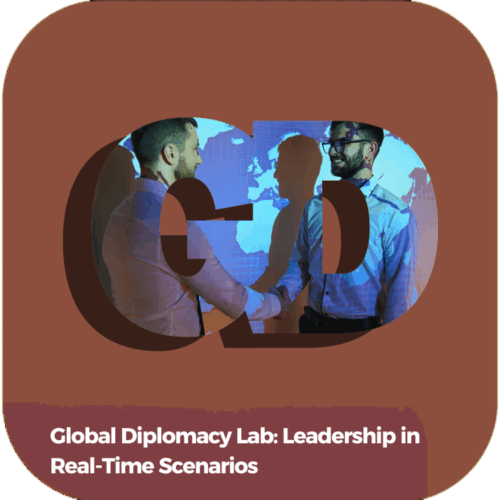 Course Description: This immersive course places participants in the center of real-time diplomatic challenges where they must lead, respond, and adapt to dynamic global events. Learners will engage in intensive simulations, rapid policy formation, and multilateral negotiation. The lab emphasizes agility, collaboration, decision-making under pressure, and cross-sector coordination to build confidence in managing high-stakes international situations. Course Length: 6 weeks (36 total instructional hours) Proficiency Level: Advanced Prerequisite: Completion of a lower-intermediate ESL course or equivalent language proficiency Course Objectives:
Course Description: This immersive course places participants in the center of real-time diplomatic challenges where they must lead, respond, and adapt to dynamic global events. Learners will engage in intensive simulations, rapid policy formation, and multilateral negotiation. The lab emphasizes agility, collaboration, decision-making under pressure, and cross-sector coordination to build confidence in managing high-stakes international situations. Course Length: 6 weeks (36 total instructional hours) Proficiency Level: Advanced Prerequisite: Completion of a lower-intermediate ESL course or equivalent language proficiency Course Objectives:- Demonstrate leadership in simulated global diplomatic crises.
- Adapt to rapidly evolving events and incomplete information.
- Coordinate interagency and cross-sector responses.
- Communicate diplomatically with public, media, and allies.
- Develop policy responses under time constraints.
- Engage in multilateral negotiations and alliance formation.
- Apply foresight, ethics, and conflict resolution in real-time.
- Debrief and analyze decisions for learning and refinement.
- Utilize digital tools to manage and track crisis scenarios.
- Create a personal action playbook for future real-world challenges.
-
 Course Description: This course focuses on the intersection of diplomacy and sustainable development. Participants will examine how diplomats engage with global development goals, aid policy, and multilateral funding mechanisms. Students will learn to design development strategies, manage partnerships, and measure diplomatic impact in support of international development outcomes. Course Length: 6 weeks (36 total instructional hours) Proficiency Level: Advanced Prerequisite: Completion of a lower-intermediate ESL course or equivalent language proficiency Course Objectives:
Course Description: This course focuses on the intersection of diplomacy and sustainable development. Participants will examine how diplomats engage with global development goals, aid policy, and multilateral funding mechanisms. Students will learn to design development strategies, manage partnerships, and measure diplomatic impact in support of international development outcomes. Course Length: 6 weeks (36 total instructional hours) Proficiency Level: Advanced Prerequisite: Completion of a lower-intermediate ESL course or equivalent language proficiency Course Objectives:- Define the role of diplomacy in advancing global development goals.
- Analyze development challenges and foreign policy alignment.
- Design aid and development strategies using evidence-based tools.
- Engage with international financial institutions and multilateral donors.
- Foster inclusive partnerships with civil society and host governments.
- Assess the impact of development assistance and project diplomacy.
- Communicate development priorities across international platforms.
- Negotiate funding proposals and cooperation agreements.
- Apply monitoring, evaluation, and learning (MEL) frameworks.
- Create a development-focused diplomatic engagement strategy.
-
 Course Description: This course explores how culture is used as a strategic tool in diplomacy to build influence, foster mutual understanding, and advance foreign policy goals. Participants will examine cultural diplomacy initiatives, global branding, soft power theory, and the design of programs that promote national image and cross-cultural dialogue. Course Length: 6 weeks (36 total instructional hours) Proficiency Level: Advanced Prerequisite: Completion of a lower-intermediate ESL course or equivalent language proficiency Course Objectives:
Course Description: This course explores how culture is used as a strategic tool in diplomacy to build influence, foster mutual understanding, and advance foreign policy goals. Participants will examine cultural diplomacy initiatives, global branding, soft power theory, and the design of programs that promote national image and cross-cultural dialogue. Course Length: 6 weeks (36 total instructional hours) Proficiency Level: Advanced Prerequisite: Completion of a lower-intermediate ESL course or equivalent language proficiency Course Objectives:- Define soft power and its role in contemporary diplomacy.
- Analyze the strategic value of cultural exchange and engagement.
- Design programs that promote national values and mutual understanding.
- Evaluate public diplomacy tools such as arts, education, and sports.
- Assess the effectiveness of global cultural diplomacy campaigns.
- Coordinate cultural initiatives with embassies and ministries.
- Align cultural programming with broader diplomatic strategy.
- Measure cultural perception and influence in global affairs.
- Foster inclusive, respectful intercultural dialogue and outreach.
- Develop a national soft power strategy for international engagement.
-
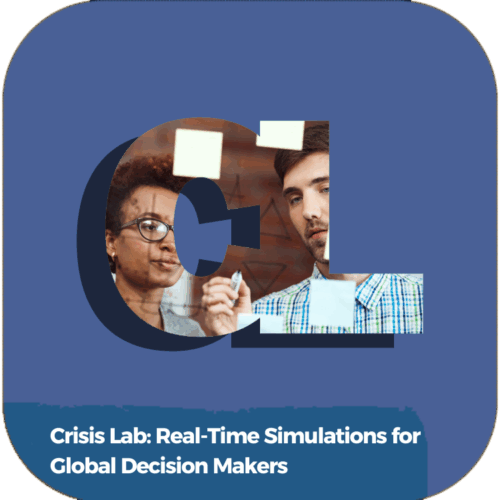 Course Description: This advanced simulation-based course immerses diplomats and global leaders in high-intensity crisis scenarios. Participants will be challenged to make strategic decisions under pressure, manage multi-stakeholder responses, and lead teams during evolving global events. The lab is designed to test diplomatic agility, communication, ethics, and leadership in the face of real-world uncertainty. Course Length: 6 weeks (36 total instructional hours) Proficiency Level: Advanced Prerequisite: Completion of a lower-intermediate ESL course or equivalent language proficiency Course Objectives:
Course Description: This advanced simulation-based course immerses diplomats and global leaders in high-intensity crisis scenarios. Participants will be challenged to make strategic decisions under pressure, manage multi-stakeholder responses, and lead teams during evolving global events. The lab is designed to test diplomatic agility, communication, ethics, and leadership in the face of real-world uncertainty. Course Length: 6 weeks (36 total instructional hours) Proficiency Level: Advanced Prerequisite: Completion of a lower-intermediate ESL course or equivalent language proficiency Course Objectives:- Demonstrate diplomatic leadership during complex global crises.
- Analyze rapidly evolving scenarios with incomplete information.
- Coordinate response strategies across ministries and alliances.
- Negotiate under pressure with limited time and shifting stakes.
- Apply ethical frameworks and values in decision-making.
- Develop clear, effective communication in high-stress environments.
- Respond to misinformation, escalation, and international scrutiny.
- Utilize digital platforms for situational awareness and coordination.
- Reflect on performance and lessons learned from live simulations.
- Design personal protocols for crisis engagement and team resilience.
-
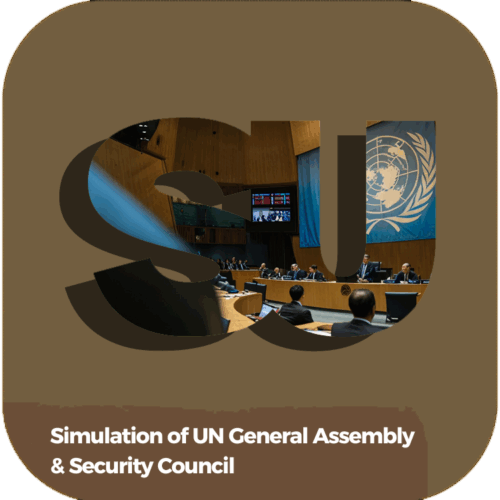
Course Description:
This intensive simulation course places participants in the roles of country delegates to the UN General Assembly and Security Council. Students will practice drafting resolutions, building alliances, negotiating mandates, and defending national interests. The course emphasizes parliamentary procedure, multilateral strategy, and leadership in global consensus-building.Course Length:
6 weeks (36 total instructional hours)Proficiency Level:
AdvancedPrerequisite:
Completion of a lower-intermediate ESL course or equivalent language proficiencyCourse Objectives:
- Understand the structure and procedures of the UN General Assembly and Security Council.
- Draft resolutions that align with international law and diplomatic objectives.
- Engage in public speaking and structured debate using formal UN protocols.
- Negotiate compromises and amendments in multilateral settings.
- Represent national interests in the context of global priorities.
- Build and manage voting coalitions and strategic alliances.
- Respond to procedural motions and chairing responsibilities.
- Apply knowledge of global issues to live UN-style discussions.
- Coordinate team positions, research, and draft language effectively.
- Lead or participate in a full-scale diplomatic simulation at the UN level.
-
 Course Description: This course immerses participants in the preparation, negotiation, and execution of high-level bilateral summits. Students will simulate leader-to-leader meetings between heads of state or senior officials, managing protocols, agenda setting, and outcomes. The course focuses on diplomatic choreography, strategic messaging, and bilateral deliverables in a highly structured and politically sensitive environment. Course Length: 6 weeks (36 total instructional hours) Proficiency Level: Advanced Prerequisite: Completion of a lower-intermediate ESL course or equivalent language proficiency Course Objectives:
Course Description: This course immerses participants in the preparation, negotiation, and execution of high-level bilateral summits. Students will simulate leader-to-leader meetings between heads of state or senior officials, managing protocols, agenda setting, and outcomes. The course focuses on diplomatic choreography, strategic messaging, and bilateral deliverables in a highly structured and politically sensitive environment. Course Length: 6 weeks (36 total instructional hours) Proficiency Level: Advanced Prerequisite: Completion of a lower-intermediate ESL course or equivalent language proficiency Course Objectives:- Understand the structure and function of high-level bilateral summits.
- Design summit agendas that balance political priorities and protocol.
- Apply negotiation strategies in formal, top-level meetings.
- Develop policy memos, talking points, and communiqués.
- Coordinate logistics, media, and delegation alignment.
- Lead or support summit simulations from pre-brief to closing statement.
- Manage sensitive issues while preserving diplomatic relationships.
- Deliver strong opening remarks and manage joint press conferences.
- Simulate behind-the-scenes problem-solving during official talks.
- Produce summit outcome documents with action plans and agreed statements.
-
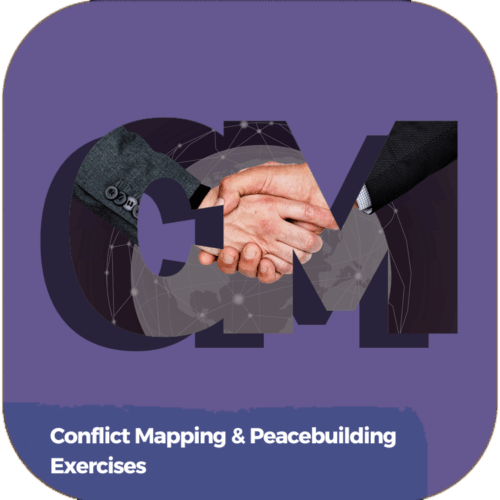 Course Description: This course equips participants with analytical tools and experiential methods to understand, map, and address violent conflict. Students will engage in interactive simulations, stakeholder analysis, and peacebuilding exercises to build skills in mediation, reconciliation, and post-conflict recovery. The course supports diplomats in fostering sustainable peace through systemic understanding and collaborative action. Course Length: 6 weeks (36 total instructional hours) Proficiency Level: Advanced Prerequisite: Completion of a lower-intermediate ESL course or equivalent language proficiency Course Objectives:
Course Description: This course equips participants with analytical tools and experiential methods to understand, map, and address violent conflict. Students will engage in interactive simulations, stakeholder analysis, and peacebuilding exercises to build skills in mediation, reconciliation, and post-conflict recovery. The course supports diplomats in fostering sustainable peace through systemic understanding and collaborative action. Course Length: 6 weeks (36 total instructional hours) Proficiency Level: Advanced Prerequisite: Completion of a lower-intermediate ESL course or equivalent language proficiency Course Objectives:- Define conflict mapping and its role in peacebuilding.
- Analyze root causes, actors, and dynamics of conflict.
- Construct conflict timelines and relationship maps.
- Evaluate peacebuilding models and approaches.
- Practice stakeholder engagement and interest analysis.
- Apply mediation and dialogue techniques in simulations.
- Design inclusive peacebuilding strategies.
- Assess risks and resilience factors for peace processes.
- Utilize visual tools for conflict transformation analysis.
- Develop a conflict-sensitive strategy for diplomatic engagement.
-
 Course Description: This course prepares embassy staff and diplomatic leaders to implement emergency protocols and lead crisis response. Participants will develop embassy-level contingency plans, conduct threat assessments, and coordinate with host governments and international partners during natural disasters, civil unrest, or security threats. Course Length: 6 weeks (36 total instructional hours) Proficiency Level: Advanced Prerequisite: Completion of a lower-intermediate ESL course or equivalent language proficiency Course Objectives:
Course Description: This course prepares embassy staff and diplomatic leaders to implement emergency protocols and lead crisis response. Participants will develop embassy-level contingency plans, conduct threat assessments, and coordinate with host governments and international partners during natural disasters, civil unrest, or security threats. Course Length: 6 weeks (36 total instructional hours) Proficiency Level: Advanced Prerequisite: Completion of a lower-intermediate ESL course or equivalent language proficiency Course Objectives:- Understand the structure of emergency preparedness in embassies.
- Develop comprehensive emergency action and evacuation plans.
- Conduct risk and threat assessments for diplomatic posts.
- Coordinate interagency crisis responses and communication flow.
- Lead internal and external communication during emergencies.
- Manage consular services and citizen assistance in crisis.
- Train embassy staff on drills, alerts, and security measures.
- Collaborate with host-country officials on contingency operations.
- Evaluate past embassy crisis responses for lessons learned.
- Create a post-specific emergency protocol and response plan.
-
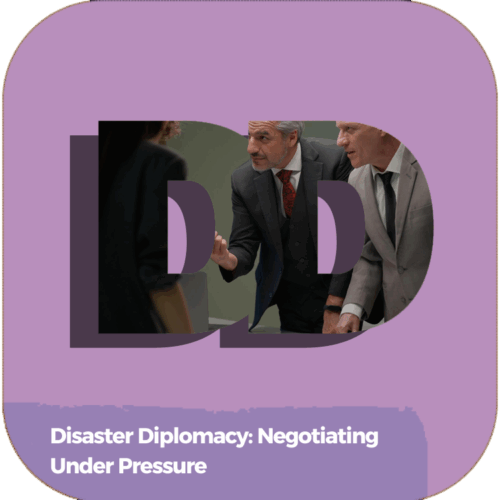 Course Description: This course explores the complex intersections between disaster response and diplomacy. Participants will analyze how natural and human-made disasters reshape geopolitical dynamics and create opportunities for cooperation or conflict. Students will simulate negotiations during high-stakes crises and design strategies that integrate humanitarian response with diplomatic priorities. Course Length: 6 weeks (36 total instructional hours) Proficiency Level: Advanced Prerequisite: Completion of a lower-intermediate ESL course or equivalent language proficiency Course Objectives:
Course Description: This course explores the complex intersections between disaster response and diplomacy. Participants will analyze how natural and human-made disasters reshape geopolitical dynamics and create opportunities for cooperation or conflict. Students will simulate negotiations during high-stakes crises and design strategies that integrate humanitarian response with diplomatic priorities. Course Length: 6 weeks (36 total instructional hours) Proficiency Level: Advanced Prerequisite: Completion of a lower-intermediate ESL course or equivalent language proficiency Course Objectives:- Define disaster diplomacy and its historical relevance.
- Analyze the diplomatic implications of major disasters.
- Coordinate international assistance during complex emergencies.
- Navigate political sensitivities in post-disaster negotiations.
- Apply negotiation techniques to humanitarian and response contexts.
- Engage in real-time decision-making simulations with diplomatic constraints.
- Design cross-sector coordination strategies in high-risk environments.
- Evaluate the impact of disaster relief on diplomatic relationships.
- Balance visibility, sovereignty, and urgency in public diplomacy during disasters.
- Develop a country-specific disaster diplomacy engagement strategy.
